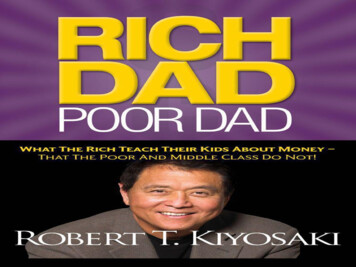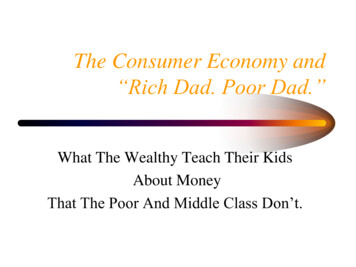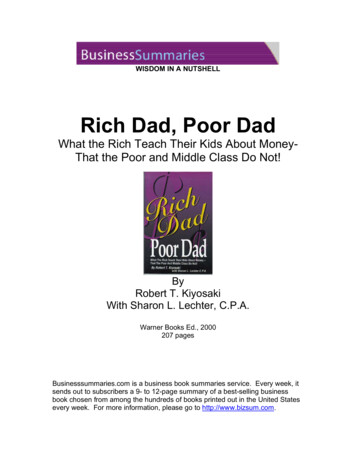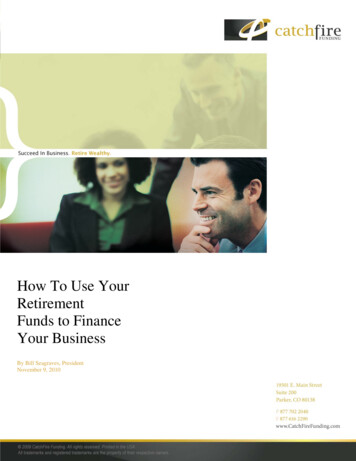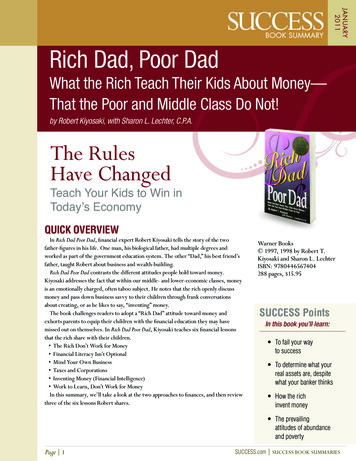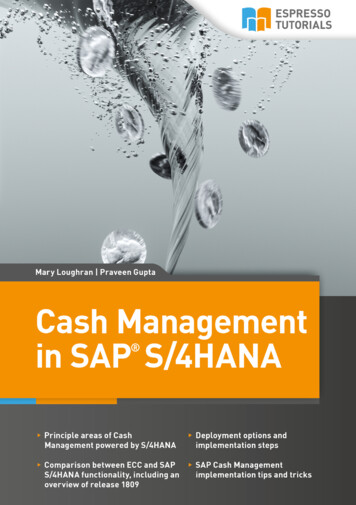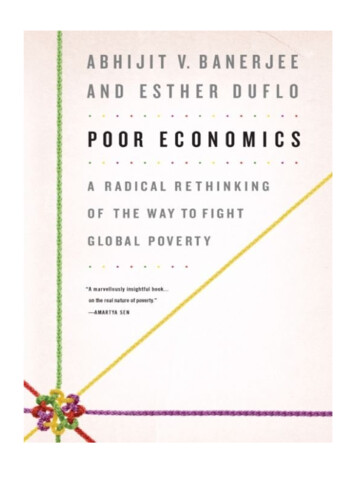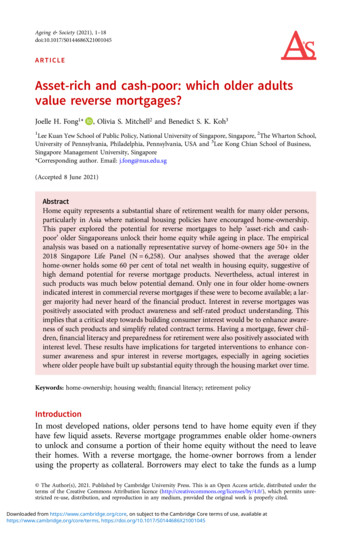
Transcription
Ageing & Society (2021), ch and cash-poor: which older adultsvalue reverse mortgages?Joelle H. Fong1*, Olivia S. Mitchell2 and Benedict S. K. Koh31Lee Kuan Yew School of Public Policy, National University of Singapore, Singapore, 2The Wharton School,University of Pennsylvania, Philadelphia, Pennsylvania, USA and 3Lee Kong Chian School of Business,Singapore Management University, Singapore*Corresponding author. Email: j.fong@nus.edu.sg(Accepted 8 June 2021)AbstractHome equity represents a substantial share of retirement wealth for many older persons,particularly in Asia where national housing policies have encouraged home-ownership.This paper explored the potential for reverse mortgages to help ‘asset-rich and cashpoor’ older Singaporeans unlock their home equity while ageing in place. The empiricalanalysis was based on a nationally representative survey of home-owners age 50 in the2018 Singapore Life Panel (N 6,258). Our analyses showed that the average olderhome-owner holds some 60 per cent of total net wealth in housing equity, suggestive ofhigh demand potential for reverse mortgage products. Nevertheless, actual interest insuch products was much below potential demand. Only one in four older home-ownersindicated interest in commercial reverse mortgages if these were to become available; a larger majority had never heard of the financial product. Interest in reverse mortgages waspositively associated with product awareness and self-rated product understanding. Thisimplies that a critical step towards building consumer interest would be to enhance awareness of such products and simplify related contract terms. Having a mortgage, fewer children, financial literacy and preparedness for retirement were also positively associated withinterest level. These results have implications for targeted interventions to enhance consumer awareness and spur interest in reverse mortgages, especially in ageing societieswhere older people have built up substantial equity through the housing market over time.Keywords: home-ownership; housing wealth; financial literacy; retirement policyIntroductionIn most developed nations, older persons tend to have home equity even if theyhave few liquid assets. Reverse mortgage programmes enable older home-ownersto unlock and consume a portion of their home equity without the need to leavetheir homes. With a reverse mortgage, the home-owner borrows from a lenderusing the property as collateral. Borrowers may elect to take the funds as a lump The Author(s), 2021. Published by Cambridge University Press. This is an Open Access article, distributed under theterms of the Creative Commons Attribution licence (http://creativecommons.org/licenses/by/4.0/), which permits unrestricted re-use, distribution, and reproduction in any medium, provided the original work is properly cited.Downloaded from https://www.cambridge.org/core, on subject to the Cambridge Core terms of use, available athttps://www.cambridge.org/core/terms. https://doi.org/10.1017/S0144686X21001045
2JH Fong et al.sum, a line of credit or as structured monthly payments. The loan is then repaidwith interest, usually on death, from the sale proceeds of the property. This is particularly important given older adults’ strong attachment to their homes, as well astheir desire to age in place if they can (Jacobs, 1986). In view of the fact that olderhome-owners can use the money to supplement retirement consumption, it is surprising that reverse mortgage markets have been slow to develop globally.Prior studies have documented underdeveloped reverse mortgage markets inAustralia, Italy, The Netherlands, Singapore and the United States of America(USA) (Phang, 2015; Fornero et al., 2016; Davidoff et al., 2017; Dillingh et al.,2017; Jefferson et al., 2017). Several reasons have been offered for the product’sslow growth, including high transaction costs (Mitchell and Piggott, 2004), precautionary savings needs (Nakajima and Telyukova, 2017) and volatile house prices(Chen and Yang, 2020). Consumer preferences also play a role since some olderadults perceive housing equity as a financial buffer against adversity, and so theyare reluctant to exploit this asset unless in crisis (Morgan et al., 1996; Leviton,2002).The complexity of reverse mortgages also makes them less appealing to financially illiterate consumers. For example, Davidoff et al. (2017) found that olderUS home-owners have limited understanding of Home Equity ConversionMortgages contract terms. Some knowledgeable home-owners expressed greaterinterest in using the product, implying that reverse mortgage take-up rates couldbe boosted via consumer education and by simplifying product explanations. Inthe Asian context, Merton and Lai (2016) argued that reverse mortgages couldbe marketed more effectively and efficiently to both retirees and their beneficiaries.A study of urban Chinese home-owners aged 45–65 found that interest in reversemortgages was positively associated with product understanding: 89 per cent of thehome-owners found reverse mortgages interesting after reading a numericaldescription of a hypothetical product (Hanewald et al., 2020).Singapore has one of the highest home-ownership rates among developed economies, with home-ownership at or above 90 per cent since the 1990s (SingaporeDepartment of Statistics, 2019). Yet few older Singaporean households accesstheir home equity, leaving them ‘asset-rich but cash-poor’ in retirement(McCarthy et al., 2002; Phang, 2018). This reality has prompted some analysts toexplore the dynamics of the reverse mortgage market, though most prior workhas approached the analysis exclusively from the supply side (Chia and Tsui,2009; Doling and Ronald, 2012; Phang, 2015, 2018). For example, Phang (2015,2018) highlighted that the products offered by private lenders were complex andhad ‘retiree-unfriendly’ design features (e.g. eligibility age of 70, 50-year minimumremaining lease on the property, etc.). With such stringent conditions imposed byfinancial institutions, the pool of housing units available for reverse mortgages isdrastically reduced. Here, by contrast, we explore the demand side for reversemortgages.Our study sought to examine the demand for reverse mortgages among homeowners age 50 in Singapore along two dimensions. First, we estimated the potential interest in reverse mortgages by studying the wealth composition of olderhome-owners. This contextualises how important housing equity is to the averageolder Singaporean, and it underscores the ‘asset-rich and cash-poor’ conclusion.Downloaded from https://www.cambridge.org/core, on subject to the Cambridge Core terms of use, available athttps://www.cambridge.org/core/terms. https://doi.org/10.1017/S0144686X21001045
Ageing & Society3Second, we drew on a module we designed to gain insights into the actual interestlevels in reverse mortgages. We also assessed the factors that independently influence consumers’ preferences in reverse mortgages, focusing on the potential effectsof poor product understanding and lack of product awareness.BackgroundNational housing policy in SingaporeSingapore is a land-scarce country with a large public housing programme knownas the Housing Development Board (HDB). Unlike public housing meant forlower-income households in other countries, HDB housing provides options fora range of socio-economic classes. Over 80 per cent of the total population livesin HDB housing (HDB, 2018), most of which consists of high-rise flats onstate-owned land; these are planned, built and allocated by the government. Theyare located in high-density housing estates which are self-contained satellitetowns with schools, supermarkets, clinics, food centres as well as recreational facilities. HDB home-owners are typically granted ownership rights for 99 years under aleasehold system that allows land to be recycled over time (HDB, 2019). Privatehousing in Singapore accounts for about 20 per cent of the total housing stockand, subject to certain conditions, HDB home-owners may invest in private properties (Phang, 2018). Over the past several decades, both public and private housingprices have experienced significant appreciation (Chia et al., 2017).Since 1968, households may make pre-retirement withdrawals from their pension accounts to finance home purchases. Public and private home purchasescan be financed through the Central Provident Fund (CPF), a mandatory definedcontribution scheme with national coverage. Plan participants contribute as muchas 37 per cent of their monthly wages to individual accounts, and part of these savings can be used as a down-payment for a house and to service subsequent mortgage payments subject to certain withdrawal thresholds (Central Provident FundBoard, 2019). The government also provides eligible public housing buyers withsubsidies. Home-ownership is believed to have generated positive externalities, public spiritedness, a sense of belonging and ‘good social behavior’ (Low and Aw,1997). It also allowed Singaporeans to share in the economic success of the countryas property values appreciated. Nevertheless, as Singapore’s population ages, adilemma confronting policy makers is how to help older adults convert their housing assets into retirement income streams.Reverse mortgage market evolutionCommercial reverse mortgages in Singapore were first offered by a local insuranceco-operative (called NTUC Income) in 1997. The programme targeted privatehome-owners age 70–90 without property loans. By 2006, NTUC Income hadissued around 350 reverse mortgage loans for private properties. In the sameyear, the government permitted HDB home-owners to take up reverse mortgages,following which NTUC Income extended reverse mortgages to this segment ofhome-owners. OCBC Bank – one of the big three commercial banks – also enteredthe market. Nevertheless, only 24 HDB home-owners took up reverse mortgagesDownloaded from https://www.cambridge.org/core, on subject to the Cambridge Core terms of use, available athttps://www.cambridge.org/core/terms. https://doi.org/10.1017/S0144686X21001045
4JH Fong et al.between 2006 and 2009, and thereafter the sale of reverse mortgages was discontinued due to lack of demand. In 2014, NTUC Income was servicing only 38 privateproperties and ten HDB reverse mortgages (The Straits Times, 2014).One supply-side explanation offered for the failure of the Singaporean reversemortgage market pertained to a contract feature which capped the maximumloan at 70 per cent of the property’s prevailing value throughout the tenure ofthe loan. If house prices were to decline, resulting in the loan breaching the cap,the lender would stop paying the borrower and take steps to recover the loan.This tail risk became apparent to the public in 2009, when a couple sued NTUCIncome alleging wrongful seizure and sale of their property (The Business Times,2009). The couple had entered into a reverse mortgage contract in 1997 whentheir home was valued at over S 2 million. By 2004, however, the house valuehad fallen to S 1.1 million, and the borrowers were informed they needed tomake cash repayments to bring down the loan to value ratio. By 2006, the borrowers’ outstanding balance had grown to over S 1 million, whereupon NTUCIncome repossessed and sold the property for just over 1 million. The couplewas then asked to pay the alleged shortfall of S 55,000. While the case was eventually settled out of court, the negative publicity and the fact that the commercialproduct permitted recourse to the lender is believed to have contributed to theearly demise of the reverse mortgage market in Singapore.MethodsData and sampleOur data were from the Singapore Life Panel (SLP) , an ongoing high-frequencyinternet survey administered for a representative cohort of age-eligibleSingaporean citizens and permanent residents age 50–70 when first recruited in2015 by the Singapore Management University. The survey includes many globallyharmonised questions on respondents’ consumption, health, employment, socioeconomic status, retirement expectations and social networks. After the baselineinterview where 15,212 persons were surveyed, monthly response rates haveremained at around 70 per cent (Vaithianathan et al., 2018). Monthly interviewstrack individual and household circumstances longitudinally. Our analysis useddata from the 2018 SLP , including a special module on reverse mortgages thatwe developed. This module assessed older adults’ interest and preferences pertaining to reverse mortgages, as well as their levels of product understanding andawareness; a detailed description of the survey is provided below.Our full study sample comprised 6,814 subjects age 50 who responded to thespecial module on reverse mortgages and who also had complete asset and wealthinformation. We identified home-owners as persons who responded ‘Yes, fully orpartly own’ to this question: ‘Do you [and/or your spouse] own or partly ownthe house, flat or apartment in which you live?’ There were 6,258 (91.8%) homeowners and 556 (8.2%) non-home-owners, for a home-ownership rate of 91.8per cent, in line with the aggregate home-ownership rate for Singapore. Becausehome-ownership is a prerequisite for reverse mortgages, we restricted our workingsample to the subset of older home-owners (N 6,258).Downloaded from https://www.cambridge.org/core, on subject to the Cambridge Core terms of use, available athttps://www.cambridge.org/core/terms. https://doi.org/10.1017/S0144686X21001045
Ageing & Society5Wealth measuresTo evaluate the potential demand for reverse mortgages, we computed each household’s net housing wealth as a share of total net worth. Net housing wealth wasoperationalised as the current market value of all residential properties less outstanding mortgage debt (if any), reported by respondents. This included thevalue of the individual’s primary and any secondary residences, and was consistentwith prior studies (e.g. Wind and Dewilde, 2018). Four separate wealth componentswere summed to obtain net non-housing wealth, as follows:(1) Net financial wealth, including checking/saving balances, investments andinsurance holdings, less outstanding debt not related to housing.(2) Non-financial assets, including business assets, and motor vehicles.(3) CPF pension wealth.(4) Non-CPF pension wealth (e.g. personal or employer-provided pensionplans).Household total net worth was the sum of net housing and net non-housing wealth.Reverse mortgage surveyOur reverse mortgage questionnaire design drew on recent research by Hanewaldet al. (2020) who surveyed urban Chinese on a similar topic. That study exploredwhether interest in commercial reverse mortgages differed between 1,100 olderhome-owners and 1,100 adult children, asking the latter whether they would recommend the product to their parents. Of note in that study was the use of a formatwhere respondents were first presented with a description of a hypothetical reversemortgage. The aim was to address the unfamiliarity that most people have withreverse mortgages, and to avoid any (positive or negative) connection with anyexisting products already offered in the market, the product was simply named‘product ABC’. Next participants were shown a numerical example illustratinghow product ABC worked. Survey participants then rated their understanding ofand interest in product ABC.We followed a similar format in our questionnaire design (for question wordings, see the online supplementary material). First, we qualitatively described ahypothetical reverse mortgage product named ‘product ABC’ offered by a largelocal bank in Singapore. Similar to previous products offered in the market, thepayouts could be in the form of an upfront lump-sum payment, monthly paymentsfor life or some other arrangement (e.g. for a fixed period of months). We also stated that no taxes would be related to the equity extraction due to the product.Second, we showed how product ABC worked using the example of a married couple who owned a property worth S 400,000 in Singapore. The property price of S 400,000 assumed in the example reflects the average home value of public housingin Singapore, and it is fairly close to the median net housing wealth observedamong our respondents. We also included relevant information on the interestrate used for valuation, payout structure and different debt repayment scenariosshould the home-owners pass away.Responses to three main questions were collated:Downloaded from https://www.cambridge.org/core, on subject to the Cambridge Core terms of use, available athttps://www.cambridge.org/core/terms. https://doi.org/10.1017/S0144686X21001045
6JH Fong et al.(1) Hypothetically, would you be interested in such products if they were available in Singapore? (Yes/No).(2) Have you ever heard of such a product? (Yes/No).(3) How do you rate your understanding of product ABC? (5 completelyclear, 4 mostly clear, 3 generally clear, 2 mostly confusing, 1 completely confusing).Question (1) sought to measure the older home-owners’ interest in reverse mortgages. Responses to this question were binary and used as the outcome variablein our regression models. Questions (2) and (3) measured product awarenessand understanding, respectively, and were used as explanatory variables in ourregressions. On the basis of previous studies revealing consumer difficulties inunderstanding financial products generating retirement income, it was anticipatedthat product awareness and understanding would be low, possibly dampeninginterest in reverse mortgages. Follow-up questions were also asked based onresponses to Question (1). If respondents answered ‘Yes’, we asked them to indicatehow they would use the funds. If respondents answered ‘No’, we asked them toindicate why.Statistical analysis and covariatesWe implemented two probit regression models to evaluate factors that could independently influence consumer interest in reverse mortgages. Aside from productawareness and product understanding, Model 1 included a standard set of sociodemographic factors and factors pertinent to financial decision-making: sex, marital status, age groups, education, currently working, income, net non-housingwealth, financial literacy, manage household finance, financially prepared in retirement, financial risk tolerance and financial planning horizon. Respondent agegroups were 50–54, 55–59, 60–64, 65–69 and 70 , while categories for educationwere: less than secondary, secondary and post-secondary. Self-rated product understanding (range 1–5) and financial literacy score (range 0–3) were coded as continuous variables. The latter is based on the ‘Big Three’ financial literacyquestions testing key concepts on numeracy, inflation and risk diversificationused to measure financial knowledge in over 20 countries (Lusardi and Mitchell,2008, 2011). Annual income and net non-housing wealth were represented inlogs. Separate indicator variables were constructed for all remaining variables.Model 2 added controls for property type (value of the primary residence in logs;have mortgage; rented out residence; have secondary property), health (fair/poor selfrated health; ever have a chronic condition; likely to live past age 75) and family networks (number of living children; bequest to children/family). We sought to determine whether a fuller specification improves model fit, and whether therelationship between interest in reverse mortgages and product awareness/understanding changed in the presence of additional confounding factors. The binary variable for ‘likely to live past age 75’ is set to 1 for persons age 75 (less than 1.5%). Forpersons below age 75, we used responses to the question ‘What is the percent chancethat you will live to be 75 or more?’, where the binary variable is coded 1 if therespondent stated a percentage greater than 50, 0 otherwise. All statistical analyseswere carried out using Stata version 16.0 (StataCorp, College Station, TX, USA).Downloaded from https://www.cambridge.org/core, on subject to the Cambridge Core terms of use, available athttps://www.cambridge.org/core/terms. https://doi.org/10.1017/S0144686X21001045
Ageing & Society7ResultsSample characteristics of older home-ownersTable 1 reports descriptive statistics of the sampled older home-owners, whoseaverage age was 61.9 and just over half (51%) were female. About 83 per centwere married and 39 per cent had post-secondary education ( 10 years of schooling). The mean financial literacy index score was 2.1 with a standard deviation of0.9, implying that older Singaporeans averaged two of three correct answers to the‘Big Three’ questions fielded. Some 85 per cent reported that they managed theirhousehold’s finances, 15 per cent had high financial risk tolerance and 42 percent had a long-term financial horizon. About 44 per cent said they were financiallyprepared for retirement. Three-fifths of the older adults were currently working,and about 20 per cent were fully retired. Annual income averaged S 58,487(US 40,940; exchange rate S 1 US 0.70) and mean net non-housing wealthwas S 529,000 (US 370,300). Although 63 per cent stated that they ever had achronic condition, only about one-third (37%) rated their health as fair or poor.Subjects had two living children on average, and 96 per cent stated they intendedto leave a bequest to their family members.The net mean value of primary residences held was approximately S 699,000(with a median of S 450,000). Since respondents were past their fifties, theirhomes were mostly paid off: the mean mortgage value was S 29,000, and only18 per cent still held a mortgage on their primary residence. Some 8.6 per centof the sample reported owning one or more secondary properties, and in this subset, the net value of the secondary property (or properties) averaged about S 1.26million. In the Singaporean context, the higher net value of the secondary propertyas compared to the primary residence is unsurprising. Many people purchase HDBflats as their first home, and if they can afford it, will later purchase condominiumssold by private developers as a secondary property for investment and rental.Share of housing wealth among older householdsThe importance of housing equity as a share of total net worth among the olderhome-owners is shown in Table 2. For an average (or mean) household, housingwealth (inclusive of primary and secondary residences) accounted for about 60per cent of net worth in 2018. Based on our estimates, even if the value of secondaryresidence(s) was excluded, housing wealth still accounted for a substantial share(52%) of total net worth for a typical home-owner. This is partly because lessthan 10 per cent of our sample reported owning secondary properties. In comparison to housing wealth, the other components constituted a much smaller proportion of total net worth. On average, an older home-owner held only 15 per cent ofwealth in financial assets, 3 per cent in non-financial assets, 21 per cent in CPFpension savings and 2 per cent in non-CPF pension savings in 2018. Wealth composition was broadly similar for the mean and the median household.This distributional analysis confirms that older Singaporean home-owners areindeed ‘asset-rich and cash-poor’. Although total net worth for our home-ownersage 50 averaged S 1,307,000, some three-fifths of this wealth was locked up in housing, most of it in owner-occupied homes. The bottom section of Table 2 providesDownloaded from https://www.cambridge.org/core, on subject to the Cambridge Core terms of use, available athttps://www.cambridge.org/core/terms. https://doi.org/10.1017/S0144686X21001045
8JH Fong et al.Table 1. Descriptive statistics of older Singaporean p characteristics:Value of primary residence (S (thousands))Mortgage on primary residence (S (thousands))Have mortgage on primary residence18Ever rented out primary residence8.9Have secondary property8.6Net value of secondary property (S (thousands)), of those owning1,2641,492Other demographic characteristics:Female51MarriedCurrent age8361.95.8Age bands:50–54855–593260–642865–691970 13Education:Less than secondary19Secondary42Post-secondary39Currently working60Fully retiredFinancial literacy score (0–3)202.10.9Manage household finances85High financial risk tolerance15Longer-term financial horizon42Financially prepared in retirementAnnual income (S )Net non-housing wealth (S (thousands))4458,48797,266529847Fair/poor health37Ever have chronic condition63Likely to live past age 75Number of living children321.9Bequest to children/family1.096Note: Percentages are shown for categorical variables; means and standard deviations (SD) are shown for continuousvariables.Downloaded from https://www.cambridge.org/core, on subject to the Cambridge Core terms of use, available athttps://www.cambridge.org/core/terms. https://doi.org/10.1017/S0144686X21001045
Pension wealthTotal net worthMean (S )Net financial wealthNon-financial 212735,025453,29969,2389,243197,7595,4866291271As % of net worthMedian 10% (S )1Net housing wealthAs % of net worth268,28420,415Percentile (S 00070,000641,19952,000Notes: 1. Refers to subjects falling between the 45th and 55th percentile of the wealth distribution. CPF: Central Provident Fund.Ageing & SocietyDownloaded from https://www.cambridge.org/core, on subject to the Cambridge Core terms of use, available athttps://www.cambridge.org/core/terms. https://doi.org/10.1017/S0144686X21001045Table 2. Distribution of wealth components for older Singaporean home-owners in 20189
10JH Fong et al.further insights by ranking respondents based on total net wealth, where we see thateven older adults with lower accumulated net worth still held substantial housingassets. For example, persons at the 30th percentile held S 350,000 in housing wealthdespite having just S 10,000 in net financial assets. Those at the 50th percentile of thewealth distribution had about S 450,000 in net housing wealth, about nine times whatthey had in net financial assets (S 50,000). Individuals at the 70th percentile hadabout S 600,000 in net housing wealth, almost four times their net financial assets.Product interest, awareness and understandingTable 3 summarises participants’ responses to the three key questions posed in ourreverse mortgage module. Interestingly, only one-quarter (26%) of the older homeowners indicated that they were interested in reverse mortgages. The remaining threequarters of the sample were uninterested, even if only hypothetically. As a follow-upquestion, those interested in reverse mortgages were asked how they would use theborrowed funds, by having them allocate 100 points across seven different (randomised) options (listed in Table 3). A large majority (76%) of the interested respondents stated that the payments from a reverse mortgage would be used to supportthemselves if they lived longer than average in retirement. Only one in ten reportedthat they would use the funds to cover expenses in retirement (presumably for medical expenses or aged care), while 8.7 per cent intended to deploy the funds to supporttheir spouse/partner in old age. A small minority indicated that the funds would bechannelled to supporting children and/or grandchildren (2.8%) or siblings (0.2%).Two additional aspects of interest are product awareness and self-rated productunderstanding. Fewer than one-quarter (22%) of older home-owners surveyed hadever heard of reverse mortgages (Table 3). This is somewhat surprising, consideringthat Singapore boosts an educated populace, e.g. four out of five respondents in oursample had at least 10 years of schooling. Over two-thirds (69%) stated that theyhad at least a generally clear understanding of product ABC (13% were completelyclear, 13% mostly clear and 43% generally clear), while 32 per cent were mostly orcompletely confused. In other words, a majority of the sample deemed the contractterms of product ABC as relatively clear. Despite this, however, only one-quarter ofthe older home-owners indicated interest in reverse mortgages.Figure 1 provides insight into why some older Singaporean home-owners areuninterested in commercial reverse mortgages. Among respondents who answered‘No’ to ‘whether interested’, a sizeable proportion (19.6%) stated that they want tohave as little debt as possible. Many older persons (19.5%) also wished to leave theirproperties to children and family members; additionally, 13.8 per cent stated thatthey did not need the extra income from housing monetisation; and 13.4 percent felt that reverse mortgages were too complex. Finally, 7.4 per cent of thoseuninterested in reverse mortgages emphasised their emotional attachment totheir homes and 10.0 per cent said they did not trust the provider (being anunnamed large local bank in Singapore in our example).Regression resultsTable 4 presents estimated marginal effects from multivariate probit regressions ofthe probability that a respondent indicated ‘interest in’ reverse mortgage productDownloaded from https://www.cambridge.org/core, on subject to the Cambridge Core terms of use, available athttps://www.cambridge.org/core/terms. https://doi.org/10.1017/S0144686X21001045
Ageing & Society11Table 3. Reverse mortgage interest, awareness and understandingN%Yes1,61426No4,54473Product interest:Would you be interested in such products if they were available inSingapore?:Missing1001.6For those who answered ‘Yes’ to the above – What would be the primaryuse of the funds?:To support myself if I live longer than average in retirement1,2287616710To have the flexibility to cover any expens
ARTICLE Asset-rich and cash-poor: which older adults value reverse mortgages? Joelle H. Fong1* , Olivia S. Mitchell2 and Benedict S. K. Koh3 1Lee Kuan Yew School of Public Policy, National Universityof Singapore, Singapore, 2The Wharton School, University of Pennsylvania, Philadelphia, Pennsylvania
